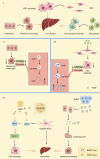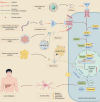Stem cell exosomes: new hope and future potential for relieving liver fibrosis
- PMID: 39510097
- PMCID: PMC12016649
- DOI: 10.3350/cmh.2024.0854
Stem cell exosomes: new hope and future potential for relieving liver fibrosis
Abstract
Liver fibrosis is a chronic liver injury resulting from factors like viral hepatitis, autoimmune hepatitis, non-alcoholic steatohepatitis, fatty liver disease, and cholestatic liver disease. Liver transplantation is currently the gold standard for treating severe liver diseases. However, it is limited by a shortage of donor organs and the necessity for lifelong immunosuppressive therapy. Mesenchymal stem cells (MSCs) can differentiate into various liver cells and enhance liver function when transplanted into patients due to their differentiation and proliferation capabilities. Therefore, it can be used as an alternative therapy for treating liver diseases, especially for liver cirrhosis, liver failure, and liver transplant complications. However, due to the potential tumorigenic effects of MSCs, researchers are exploring a new approach to treating liver fibrosis using extracellular vesicles (exosomes) secreted by stem cells. Many studies show that exosomes released by stem cells can promote liver injury repair through various pathways, contributing to the treatment of liver fibrosis. In this review, we focus on the molecular mechanisms by which stem cell exosomes affect liver fibrosis through different pathways and their potential therapeutic targets. Additionally, we discuss the advantages of exosome therapy over stem cell therapy and the possible future directions of exosome research, including the prospects for clinical applications and the challenges to be overcome.
Keywords: Autophagy; Exosomes; Hepatic fibrosis; Inflammation factor; Oxidative stress.
Conflict of interest statement
The authors declare no conflict of interest.
Figures




References
-
- Hernandez-Gea V, Friedman SL. Pathogenesis of liver fibrosis. Annu Rev Pathol. 2011;6:425–456. - PubMed
-
- Poisson J, Lemoinne S, Boulanger C, Durand F, Moreau R, Valla D, et al. Liver sinusoidal endothelial cells: physiology and role in liver diseases. J Hepatol. 2017;66:212–227. - PubMed
-
- Trebicka J, Bork P, Krag A, Arumugam M. Utilizing the gut microbiome in decompensated cirrhosis and acute-on-chronic liver failure. Nat Rev Gastroenterol Hepatol. 2021;18:167–180. - PubMed
Publication types
MeSH terms
Grants and funding
LinkOut - more resources
Full Text Sources
Medical

